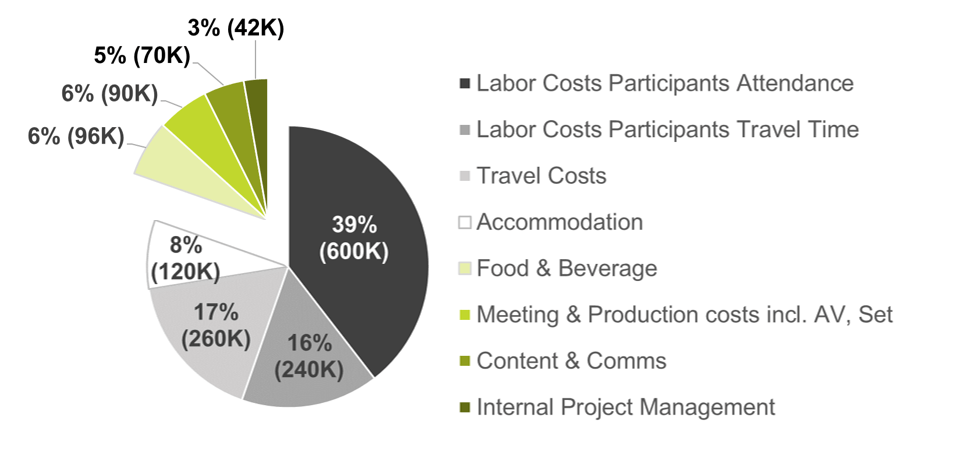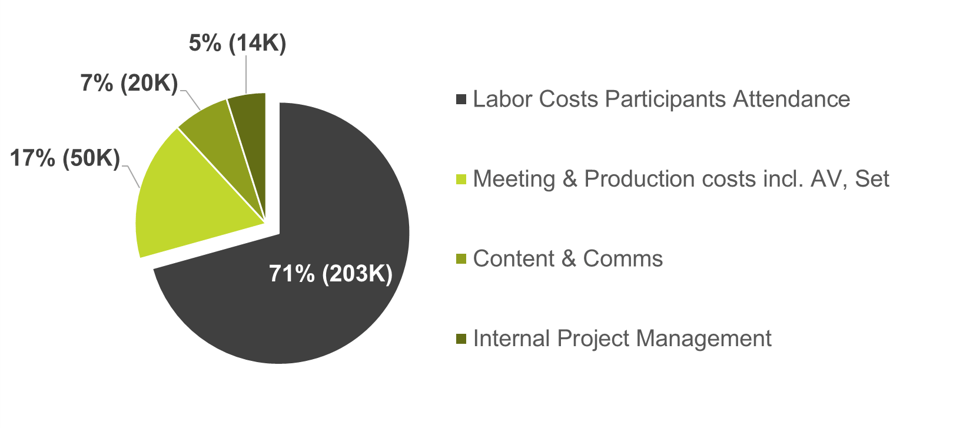A Call for Transparency – Total Meeting Costs (1/5)
Over the next few weeks we will publish a series of blog posts around the topic of meeting impact measurement (ROI and ROO) and experience design. The goal is to raise awareness of the importance to measure meeting/campaign success in order to justify meeting investments and to have a strong tool set to continuously improve meeting value through intelligent experience design. But before we dive deep into the impact measurement and value based content / learning environment improvement we need to have full transparency of the actual costs of meetings.
Actual Meeting Costs – A call for transparency
Meetings and events are costly on the one hand but ultimately provide value to stakeholders on the other hand. They should therefore be considered and treated as investment. But: If you don’t know the input how can you judge if the meeting output is worth the investment?
Total event costs for external meetings & events are usually quite transparent whereas for internal events and meetings they very often “deliberately” lack of transparency since the most important cost factors get ignored. This is mainly because meeting costs are usually allocated to different cost centers, countries and divisions.
Standard Examples
To bring more clarity we take a closer look at the cost structure of two hypothetical examples of a meeting: i) a typical Leadership Meeting and ii) a standard Hybrid Townhall Meeting.
i) In the chart (pie, % & CHF) below the cost repartition of a typical Leadership Meeting (2 days) with 200 participants is displayed (cf. definition / assumptions thereafter).

Assumptions: 2 day meeting, 200 persons mid-to senior leadership, large international company, 40% no travel time since meeting location close to Headquarter, 30% short haul flight economy, 30% long haul flight business class, average annual gross salary CHF 250’000.-, plus 30% Employer Contribution (e.g. in Social Security), 220 working days, 10 hours per working day.
Roughly 80% (CHF 1.2 Mio) of total meeting costs of CHF 1.5 Mio. consist of labor costs (time at meeting and travel time) plus travel costs and on-site accommodation costs (black to white areas in chart). Travel and accommodation cost are usually covered by the participants and are therefore not part of the actual meeting budget of the meeting host. This leads to the fact that only the remaining 20% (CHF 300K) are usually covered by the actual approved meeting budget (green areas in chart).
ii) The chart below shows an example of the costs of an on-site standard Hybrid Townhall Meeting (90 min.) with 1’500 participants (cf. definition / assumptions below chart). Here we have no travel time and travel costs, but labor costs still represent 71% of total costs.

Assumptions: 90 Minutes Hybrid Townhall Meeting, 4 Locations connected via Videoconferencing with 300 participants present at locations and 1’200 participants participating via webcast. Average gross salary CHF 120’000. 30% % Employer Contribution (e.g. in Social Security), 220 working days 8h/day.
Entrepreneurial awareness: Meeting hosts need to be aware and feel responsible for the entire costs structure that affects the company in order to take the adequate decisions, which are ultimately achieving the highest meeting value (i.e. highest ROI). Taking into consideration actual costs when hosting a meeting or event is the proper principle that is in line with entrepreneurial thinking and the general language of business.
Increasing value by reallocating resources
Only 10-15% of total meeting costs are generating a return (that is content, learning environment and experience design) and therefore need to be optimally allocated to achieve the highest ROI possible.
The ROI Methodology of meetings and events states different variables that can improve the ROI of a meeting and event. At the base of everything: A meeting can only generate an impact with the right target audience. Since 90% of total meeting costs vary depending on the number of participants, it is of upmost importance to carefully evaluate whether the right participants are attending the meeting. Reducing the attendance by 10% (which consists of 20 participants that are not considered “target audience”) at the Leadership Meeting results in a saving of CHF 130K. If this amount would be reallocated and invested in content that results in a higher impact on the participants (and therefore on the company as well), the investment in value driving content could be increased from 190K to 320K (+68%) which in turn has outweigh above average by large outpace the loss of 10% attendance.
Learnings: If you need to save, start with looking at the target audience (see more details here). Reduce participants, try to save travel time and travel costs but don’t touch on value driving elements such as content (and its further roll-out into the company), learning environment as well as experience design.
Do you want to know how we can help you to better understand your meeting costs and squeeze more value out of your budget? Contact us today to schedule a meeting!
___________________________________________________________________________________________________________________
More of our series on impact measurement (ROI and ROO) and efficient experience design:
- Proving value through strategic impact measurement – ROI & ROO (2/5)
- Target Audience and the Importance of Personas (3/5)
- Perfect Meeting Environment to Optimize ROI & ROO (4/5)
Comments
-
-
-
The Perfect Meeting Environment to optimize ROI & ROO (4/5) - Vischer, Merkt & Partner ‐ 4. December 2019[…] A Call for Transparency – Total Meeting Costs (1/5) […]
-





